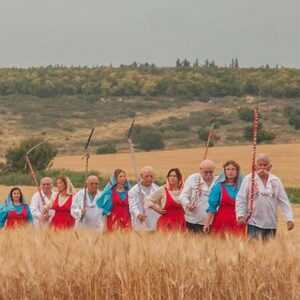Field in Spring Susan Stewart, 1952
Your eye moving left to right across the plowed lines looking to touch down on the first shoots coming up like a frieze from the dark where pale roots and wood-lice gorge on mold. Red haze atop the far trees. A two dot, then a ten dot ladybug. Within the wind, a per- pendicular breeze. Hold a mirror, horizontal, to the rain. Now the blurred repetition of ruled lines, the faint green, quickening, the doubled tears. Wake up. The wind is not for seeing, neither is the first song, soon half- way gone, and the figures, the figures are not waiting. To see what is in motion you must move.
This time of the year, between Pesach and Shavuot, is an interesting time of change. As we count the days and weeks which pass from one holiday to the other, suddenly spring turns to summer.
In the past, Omer Counting marked the days between the beginning of barley harvest – the earliest of grains (which take their time filling up and ripening), harvested from the day after Pesach, till the beginning of wheat harvest,– towards Shavuot. The bread baked from barley flour was harder and coarser (usually, barley was used for animal food), and farmers and their families would actually count the days till they could bake nice, lithe loaves of bread, so much tastier. It is no wonder then that they counted the days till they could feast on soft pita bread…


Last Tuesday we were showered with a good amount of rain. The hay and wheat growers in our area hurried to harvest their fields the days before, gathered and stored the yield in a nice dry place. This time of the year, in between barley and wheat harvesting, is the period of almost reaching the harvesting in song part, when the yield has almost arrived at its finish line and therefore can easily be lost just as it is about to be declared a great success. Which is why it’s a time of great expectation combined with a great deal of anxiety and stress. Sultry hamsin winds, unpredicted torrential rain, a sudden pest infestation – all these can rob the hardworking farmer his/her fruits of labor, just as s/he is ready to emit a sigh of relief and rejoice in his/her achievement. Which is why this has always been a time of waiting and praying and carefully bowing a head before the Lord, the earth, nature.
In strong agricultural societies, these days were filled with cooperation and gestures of mutual assistance. Farmers knew their greatest chance of overcoming difficult times, succeeding in their endeavors and conquering the inconveniencies is by uniting and working together in the fields, lending tools to each other, helping farmers in distress. They worked to find a middle path and solve their disputes, replacing the usual power struggles with compromise, knowing those struggles will only sabotage their hard work and eventually cause everyone to lose their yield.
In our small, fragmented country, this is the time of the year laden with memorial and national days, beginning with Yom HaShoah through Yom HaZikaron for IDF soldiers and victims of terror attacks, Independence Day and finally Lag Ba’Omer. These too are days summoning closeness and good friendly companionship. Instead of disputes and struggles over dignities and ego, instead of closing up and feeling threatened, perhaps we can choose the path of togetherness and allow a place and voice to our kin. Perhaps the power of collaboration will open our hearts up to the other. Ha-levai…..
At Chubeza, this is a season of counting: fewer and fewer winter vegetables in your boxes; two more broccoli beds, one more broccoli bed; two more rounds of fennel, one…; five weeks of carrots, four, three, two, one … 500 cauliflowers to go, 400, 200, 50… and one last round of kohlrabi…
At the other end of the spectrum, we are slowly counting the additional new summer vegetables, this time it’s an upward count: 10 kg of squash, 80 kg of squash, lo and behold- 300 kg! Enough for all of the boxes! And soon our spring potatoes will emerge chubby and covered in damp dirt, to be followed joined soon by new spring cohorts: string beans, melons, fakkus…
Almost every year, the transitional seasons are those where there are fewer vegetables ripe for the picking in the field. Though the field abounds with planted vegetables, there are still winter vegetables and many summer vegetables seeded, planted, and blooming- all at various stages. But this year, the spring vegetables are taking their time.
The mild spring is making us very happy when we’re out in the field, enjoying every warm hour (as opposed to the “scorching” hours yet to come) and overcast days that minimize the sunrays. At the deep end, the earth is still saturated with moisture, making it easier for the new vegetables – after a little help getting them acclimated in the earth – to send out their roots and reach the winter rains stored within.
We wish our vegetables a true-to-themselves growth, balanced and in sync with the weather, bugs, sunshine and other components of the symphony of spring. May the growth be accompanied by good health and the ability to take on the challenges of the upcoming summer. We shall welcome each crop with joy upon its arrival, and know that you rejoice along with us.
Wishing you all a good week, of timely occurrences and the patience to let things happen at their own rhythm! May we have a week of togetherness, an eye-to-eye gaze and a touch of benevolence.
Alon, Bat Ami, Dror, Yochai and the whole Chubeza team
____________________________________
In the Box this week:
Monday: Swiss chard/kale, carrots, lettuce, cucumbers, onions, tomatoes, parsley root, fennel/kohlrabi, zucchini, betts, potatoes.
Large box also: leek, celery/celeriac, cilantro/parsley/dill.
Wednesday: Swiss chard/kale, carrots, lettuce, cucumbers, onions, tomatoes, , fennel/kohlrabi, zucchini, celery/celeriac, beets, potatoes.
Large box also: Parsley root, leek, cilantro/parsley/dill.
